Sometimes you just need noodles! From japchae to shrimp lo mein to dan dan noodles and ramen (and all stops in between), here are 30 delicious Asian noodle recipes you can easily make in your home kitchen that taste better than takeout!
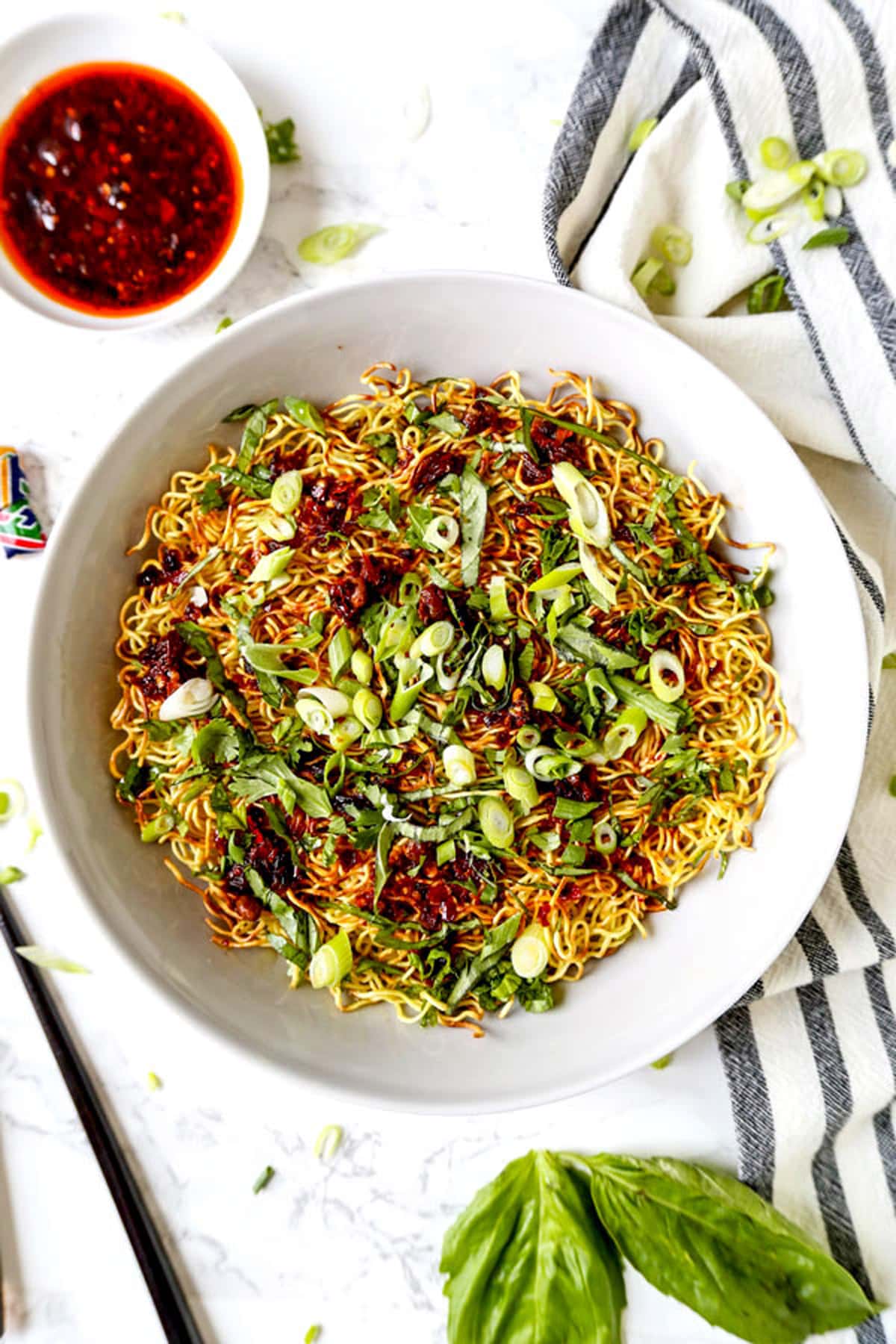
I’ve got a serious weakness for noodles. Because whether I’m cooking with rice noodles, ramen noodles, Chinese egg noodles or straight up spaghetti – a bowl of noodles can take on so many flavors.
Any ingredient where the flavor profile options are literally limitless, is a winner in my book.
These Asian Noodle Recipes Won’t Take All Day
Whether you decide to make lo mein, Chinese garlic noodles or a feisty pad Thai – it shouldn’t take all afternoon to make dinner!
Most of these easy Asian recipes can be made in under 30 minutes – with a huge share of them coming in at the 10 or 15 minute mark.
Keep in mind: all noodle brands are a little different. When it comes to boiling or steeping times – I’d advise following the boil timing suggestions on the package instructions so your home cooked creations turn out perfectly.
So, without further ado, here’s a month’s worth of Asian noodle recipes you can easily make at home!
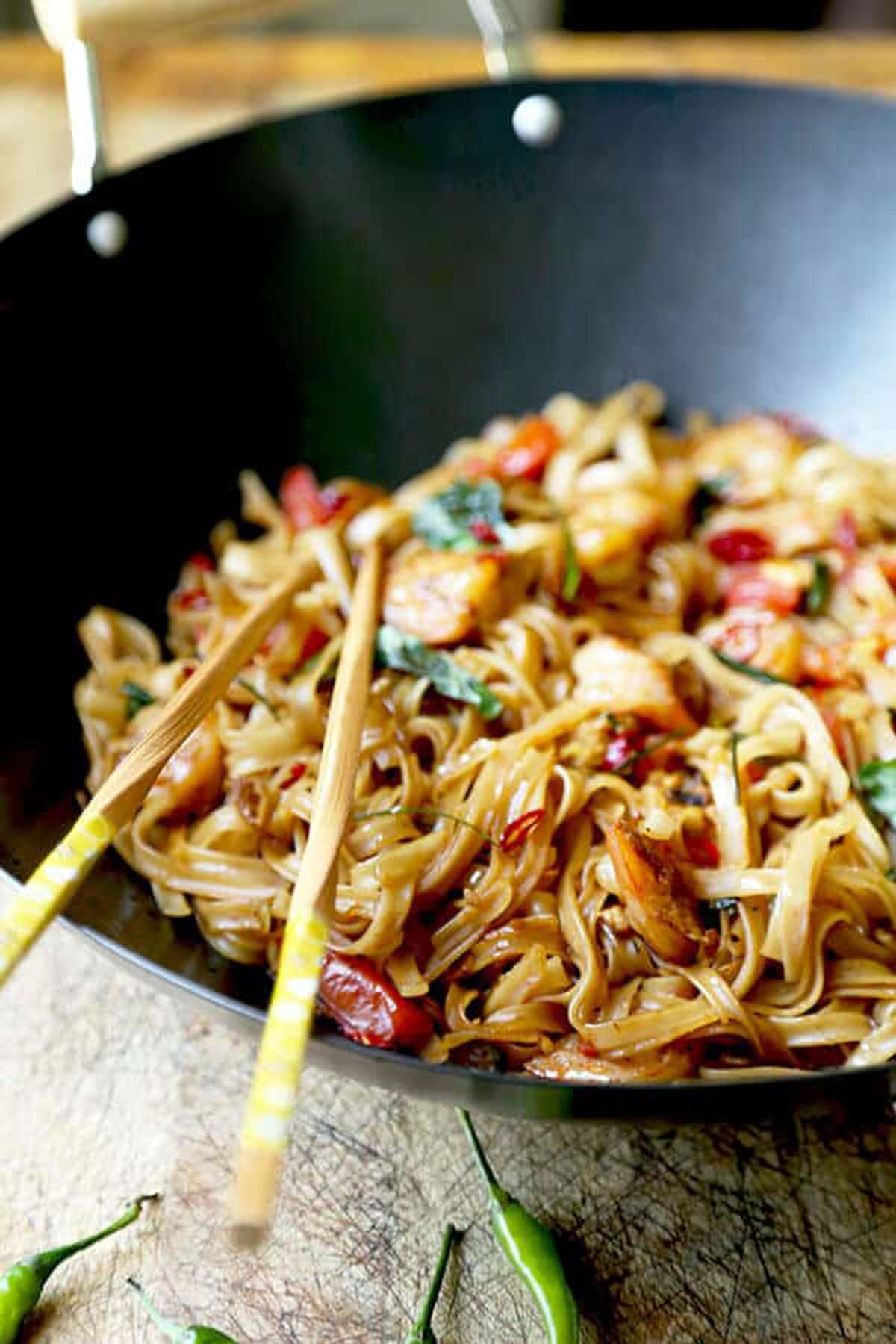
Drunken Noodles – Pad Kee Mao
This fragrant Thai noodle recipe tastes like you just sat down to eat at an open-air Bangkok food stall. Savory, sweet and herbaceous rice noodles with garlic, shrimp, tomatoes, kaffir lime leaves and basil. And don’t forget Thai classics like bird’s eye chilis, fish sauce and a little sweet soy sauce for the full taste experience. This is one of my favorite Asian noodle recipes of all time – because the taste transports me to my favorite food stall in Krung Thep!
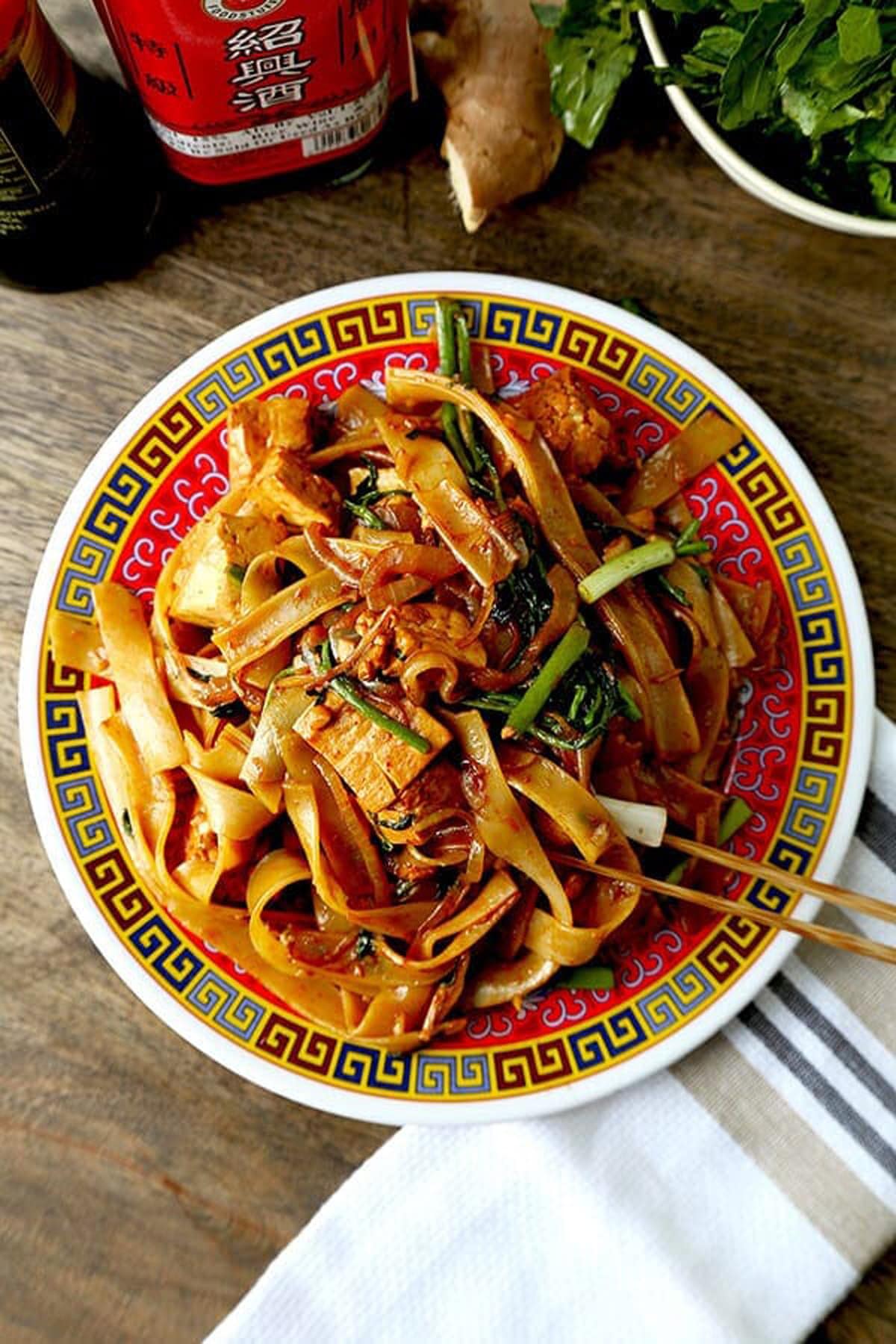
Tofu Chow Fun With Watercress
These simple stir-fried noodles are always a hit. It’s a simple mixture of tofu, watercress and flat rice noodles. The secret to whipping restaurant quality Chinese noodles up at home is using shaoxing wine and chinkiang vinegar. Oh… and make sure your wok or frying pan is nice and hot. There’s nothing like imparting a little wok hei to your homemade chow fun whenever possible.

Pan Fried Noodles With Chili Crisp
I got hooked on this Chinese pan fried noodle dish when I lived in Hong Kong. Blanketed in fragrant herbs and smoky, funky heat from chili crisp. The texture of the noodles themselves is a mixture of crispy and chewy. Actually the chili crisp does most of the heavy lifting in the flavor department, so the most labor intensive part of this iconic recipe is the quick pan frying of the chow mein noodles in a large skillet. Super easy and so delicious!

Shrimp Lo Mein
Lo mein noodles have been on literally every Chinese delivery order I’ve placed in my life. Let’s be real, there’s a lot to love about lo mein – and that’s why it’s one of the most iconic Chinese noodle recipes in the West. I like using cabbage, snow peas, carrots and red bell pepper for my veggies – but use what you’ve got handy and like best in your lo mein. If you’re making shrimp lo mein, I recommend pre-cooking the shrimp, removing them just shy of done, then adding them back to the wok once the lo mein sauce has been mixed in and your dish is almost ready to serve (so they stay springy). Oh, and don’t forget a dusting of white pepper!

Easy Cantonese-Style Chow Mein / Sara Udon
Cantonese chow mein (AKA: Hong Kong chow mein) has a bottom layer of crispy pan fried noodles, topped with a thick, savory sauce featuring veggies, seafood and/or meat. Once the sauce goes on top, the noodles start to soften from the heat. Interesting fact: Cantonese chow mein runs significant parallels to one of my favorite Japanese noodle recipes: Nagasaki sara udon. No matter what you call it though, you’ll love these crispy noodles in a simple sauce featuring sake, oyster sauce and a dash of sesame oil. So much better than takeout!
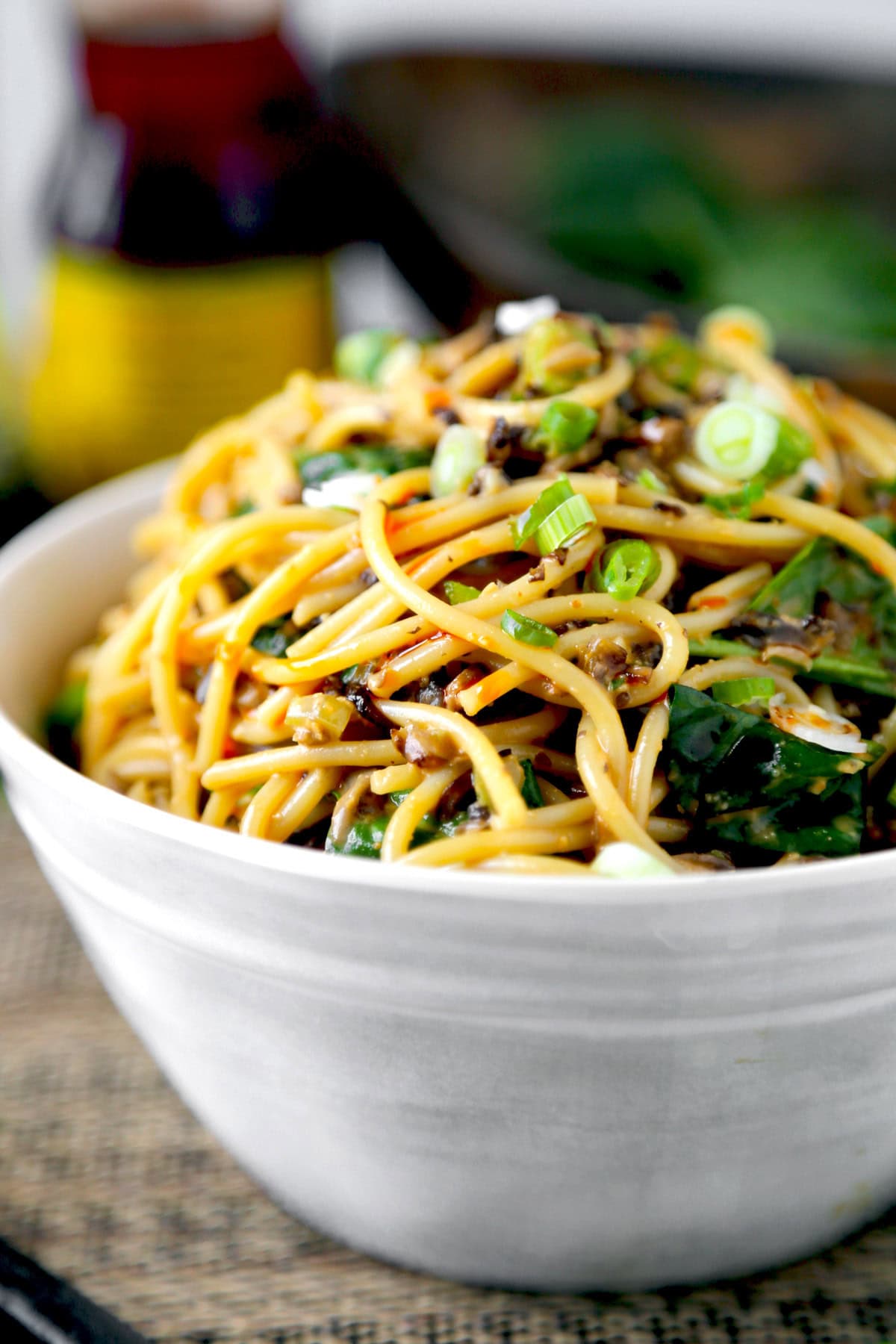
Vegan Dan Dan Noodles
Sometimes you don’t mess with the classics. And sometimes a simple substitution can be a revelation. Finely chopped mushrooms replace the pork you’d typically use in dan dan noodles. And the umami notes they impart to this Chinese noodle recipe render the dish as good (if not better) than the classic. For the sauce, you’ll use a couple cloves of garlic, minced ginger for heat – alongside rice vinegar, chili oil, peanut butter and soy sauce. Chopped green onions are the best crunchy topper.
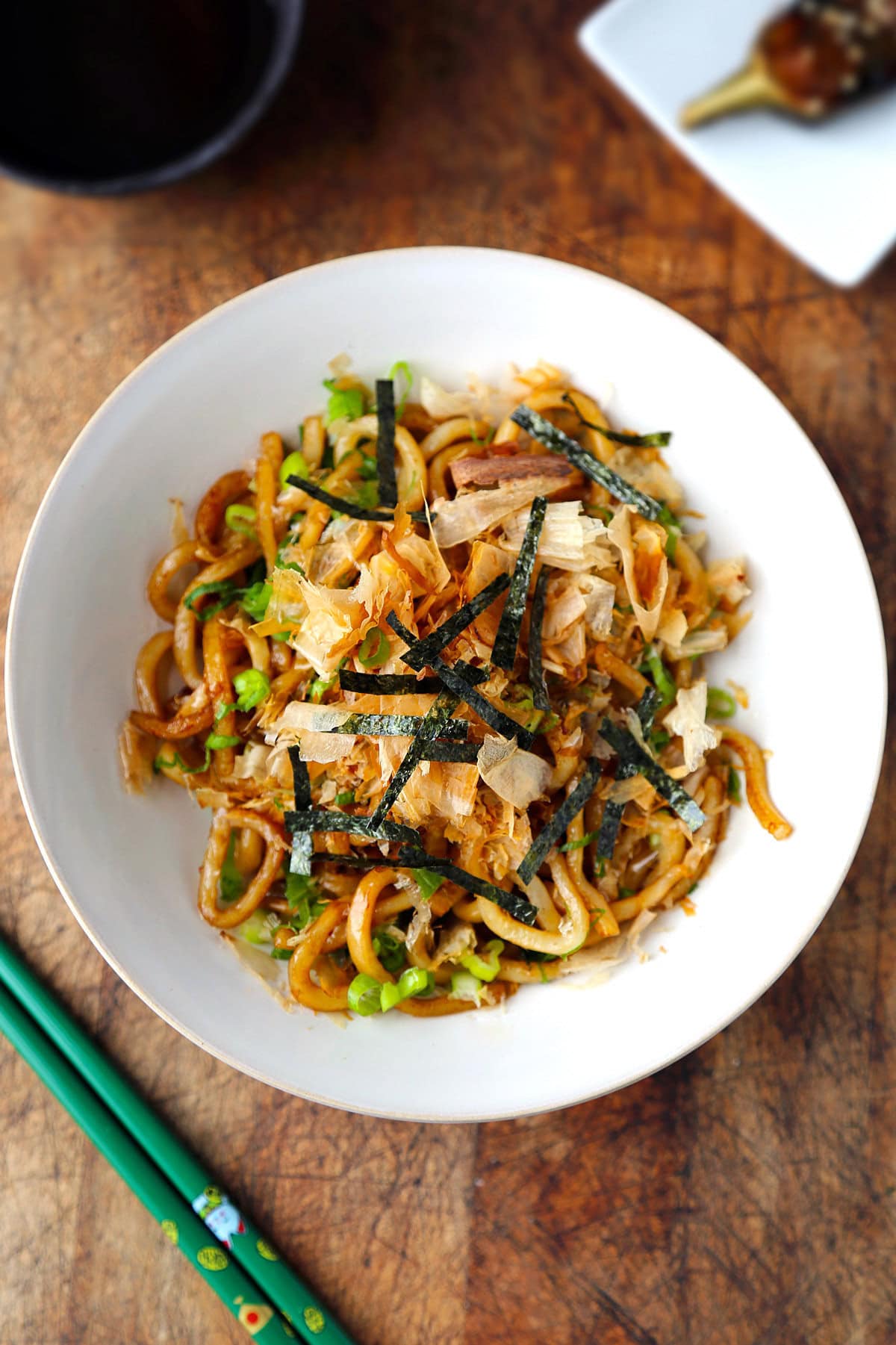
The Best Yaki Udon – 焼きうどん
This is one of those rustic Japanese recipes that makes me feel like I’m sitting in an izakaya in Fukuoka with my mom and her family. Udon noodles are thick, chewy and springy – and do the best job of soaking in the simple yet assertive flavors of butter, soy sauce and dashi powder. If you’ve only got 10 minutes to cook, you’ve actually got more time than you’ll need to whip up this seven ingredients yaki udon recipe. Top with chopped scallions, bonito flakes and nori for the full izakaya experience.
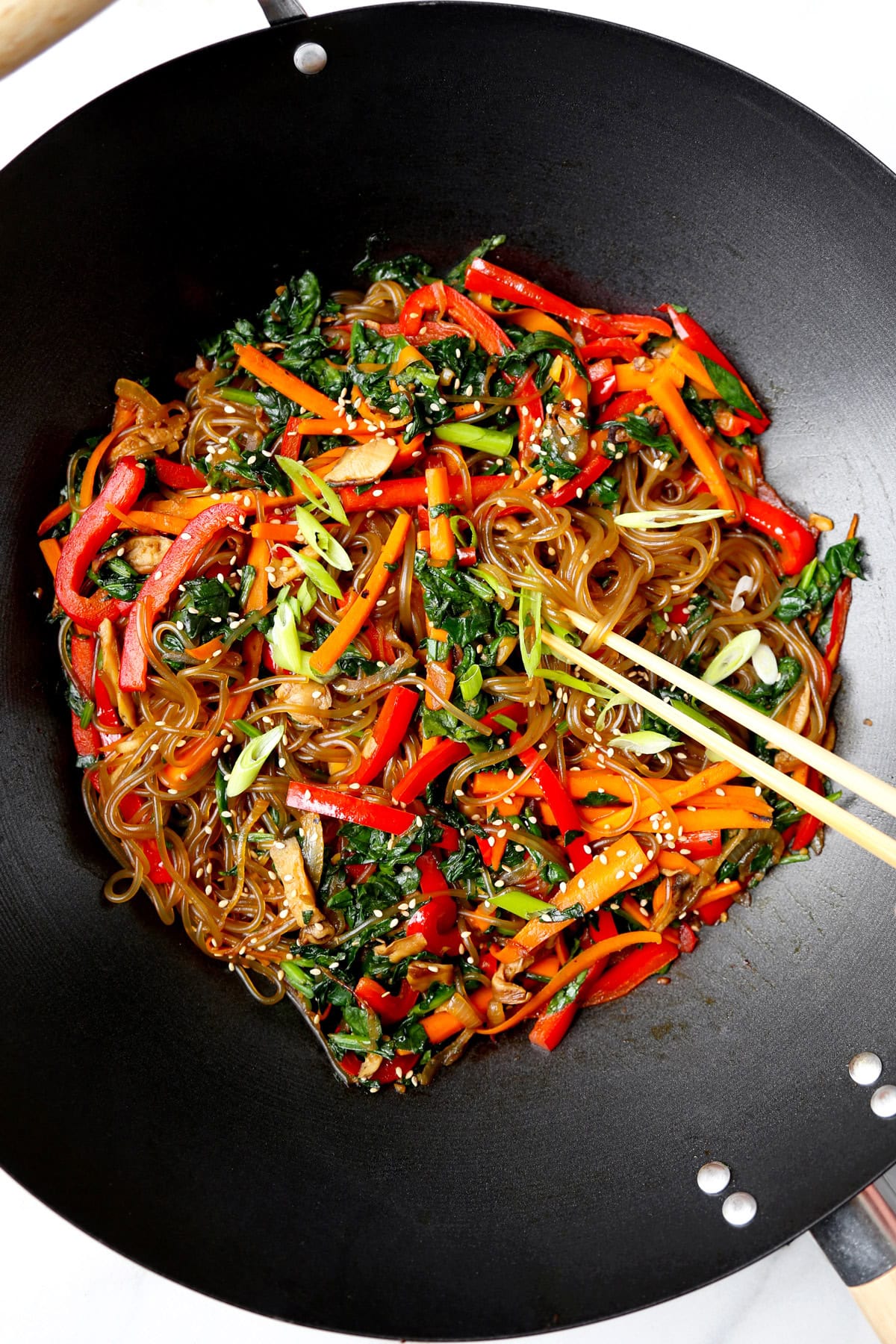
Easy Japchae – Korean Glass Noodles
If chewy Korean glass noodles mixed with colorful veggies in a sweet, savory and nutty sauce sounds good to you, this is the noodle recipe you’ve been looking for! Even though this is technically a recipe for stir fry noodles, japchae is commonly served at room temperature. The secret is keeping the veggies just crunchy enough that they contrast the chewy, slippery glass noodles. A light sprinkling of toasted sesame seeds makes this classic Korean noodle recipe look as good as it tastes.
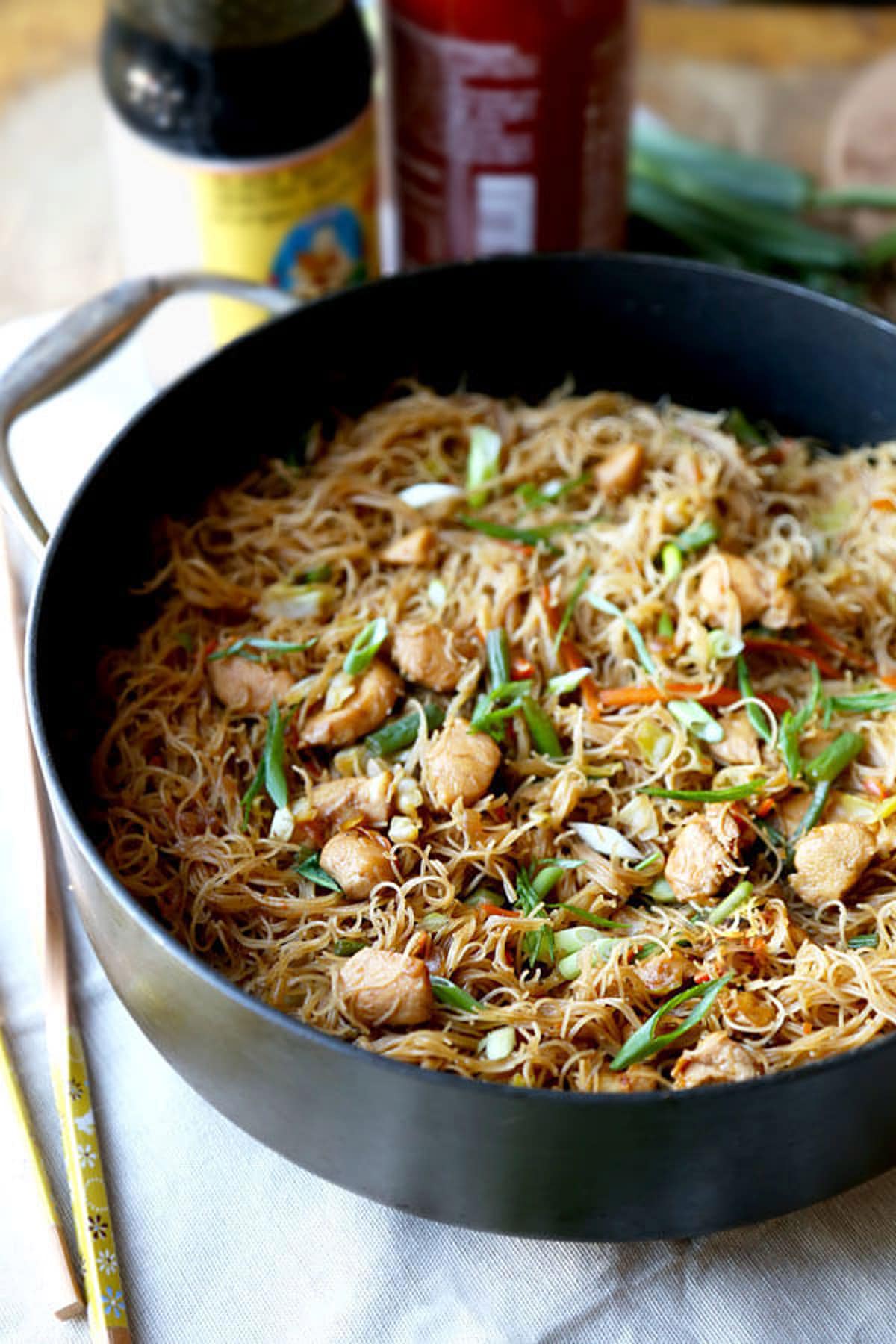
Easy Pancit Bihon
This traditional Filipino noodle dish is a favorite worldwide – and it’s easy to see why. Chicken and veggies just go with noodles. Now, actual bihon noodles are made of cornstarch and rice flour. However, they’re very similar to rice noodles and rice vermicelli – so those make great substitutes in a pinch. The best part is that the noodles cook in (and soak up) the savory and sweet sauce – so the assertive flavor is infused into the noodles themselves. Pancit is one of those hearty Asian noodle recipes that eats like a full meal. Must try!
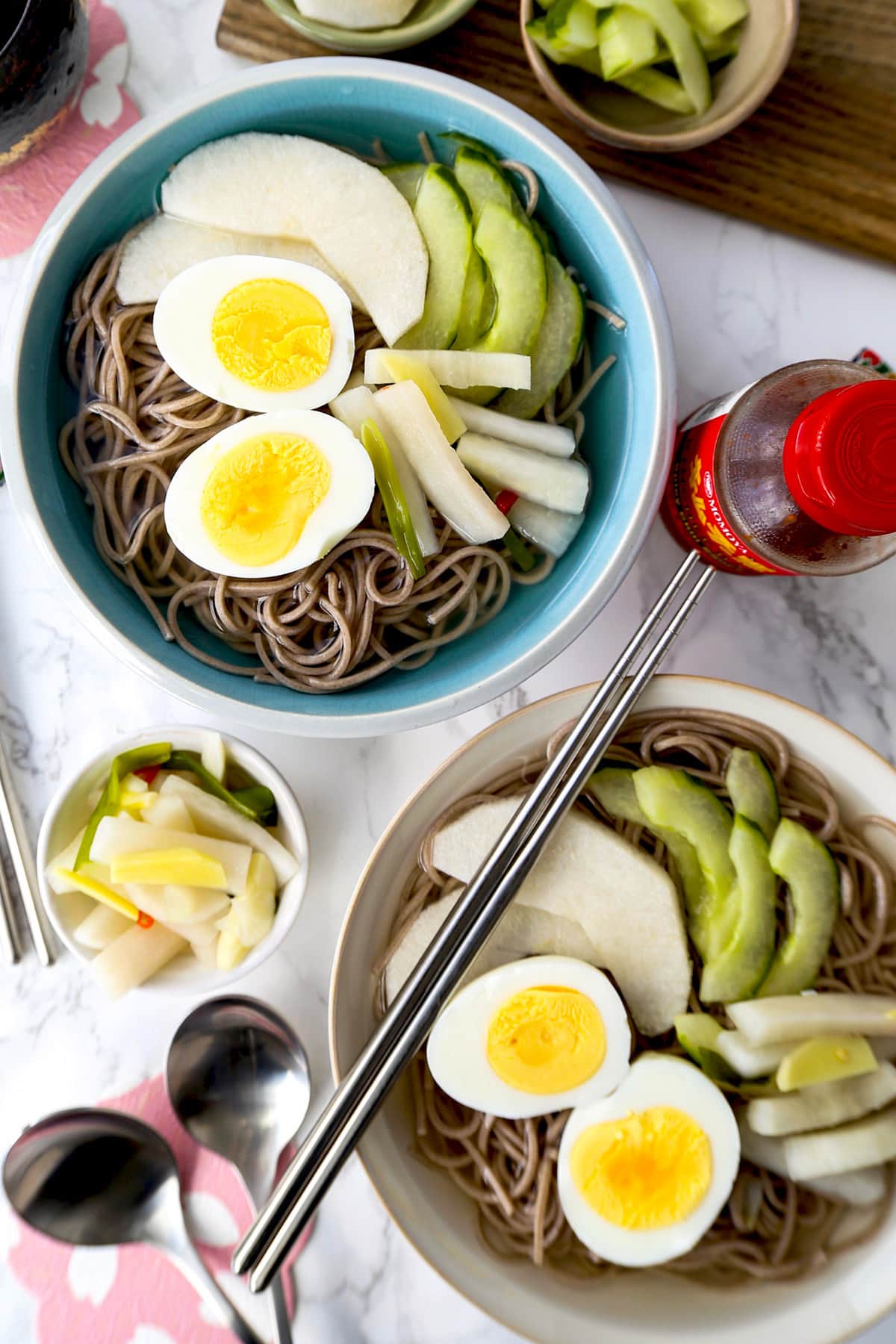
Naengmyeon (Korean Cold Noodles – 냉면)
As summer temperatures reach their blinding apex, there’s no better lunchtime antidote than these cleansing and refreshing cold Korean noodles. Buckwheat noodles are placed in a frigid broth that is actually a sour and salty dongchimi brine. Top with a creamy boiled egg, sliced Asian pear, cucumbers and dongchimi pickles for the full experience.
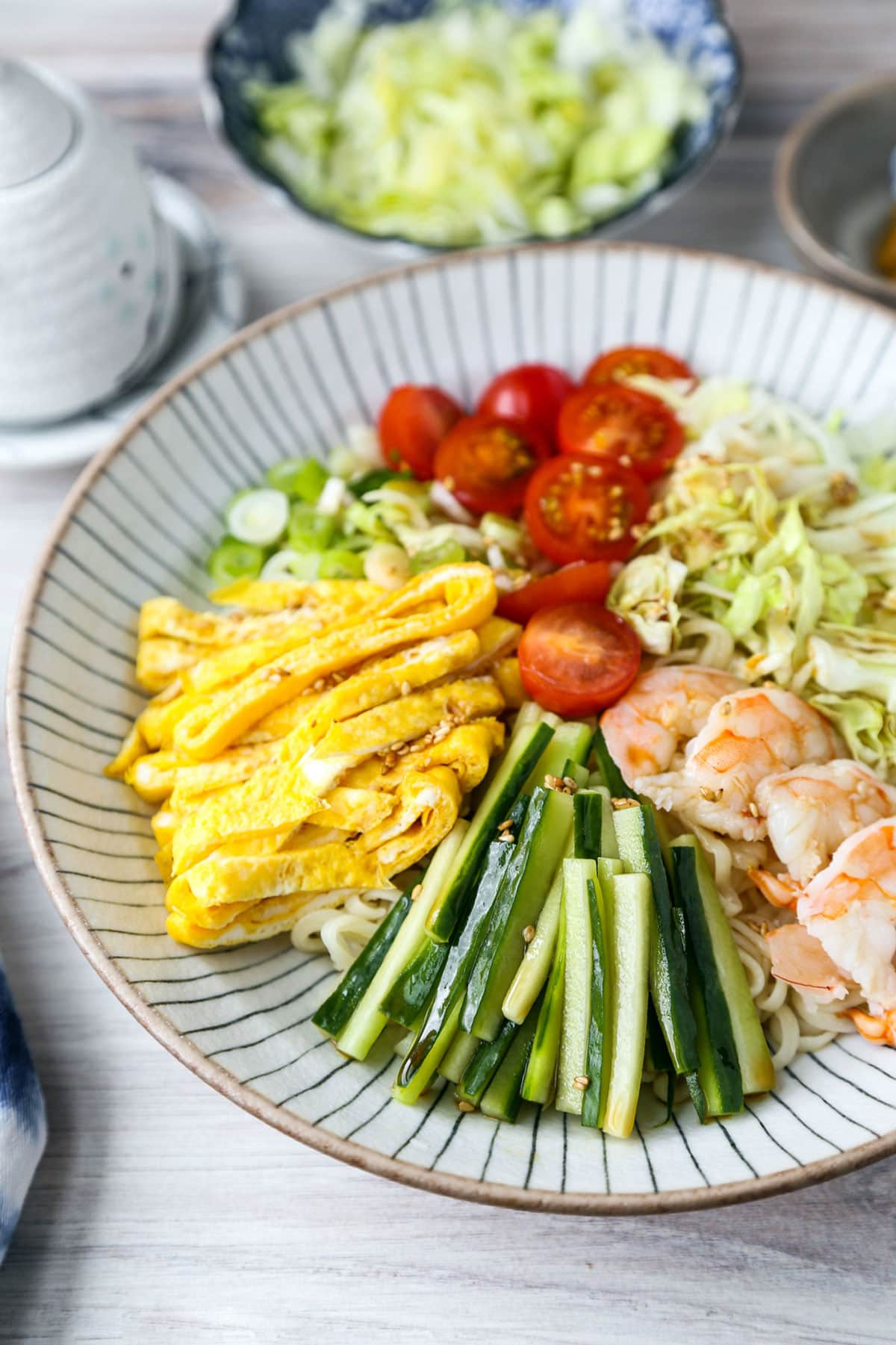
Hiyashi Chuka (Chilled Ramen Salad)
In keeping with the refreshing cold Asian noodle recipes, this Japanese hiyashi chuka is my personal favorite way to eat and still beat the heat. This chilled ramen noodle salad is commonly served with ribbons of sliced egg omelette, lettuce and cucumbers. Instead of the traditional ham, I opted for shrimp – but if you’re keeping it OG at your place, you know what to do. Mixing salad and cold ramen noodles is an all-pro move. And the soy and rice vinegar based broth will have everyone slurping.
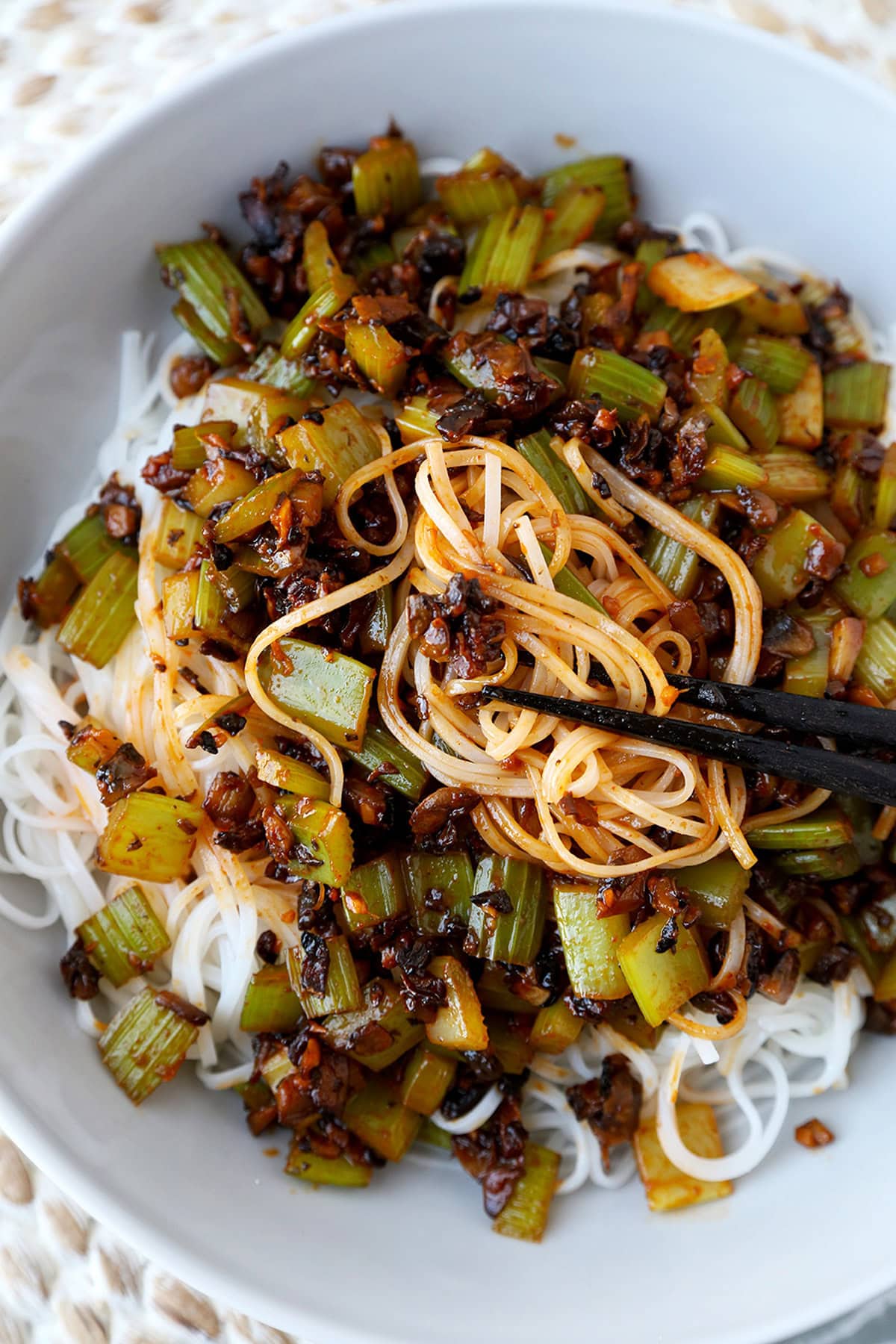
Spicy Vegan Sichuan Noodles
These vegan Chinese noodles are spicy without being volcanic. The slow burn comes from fresh ginger and gochujang – mixed with chinkiang vinegar and soy sauce. Diced mushrooms and celery are stir fried in the spicy sauce – and then placed atop rice noodles. Only 8 ingredients – and ready in 20 minutes from start to finish 🔥
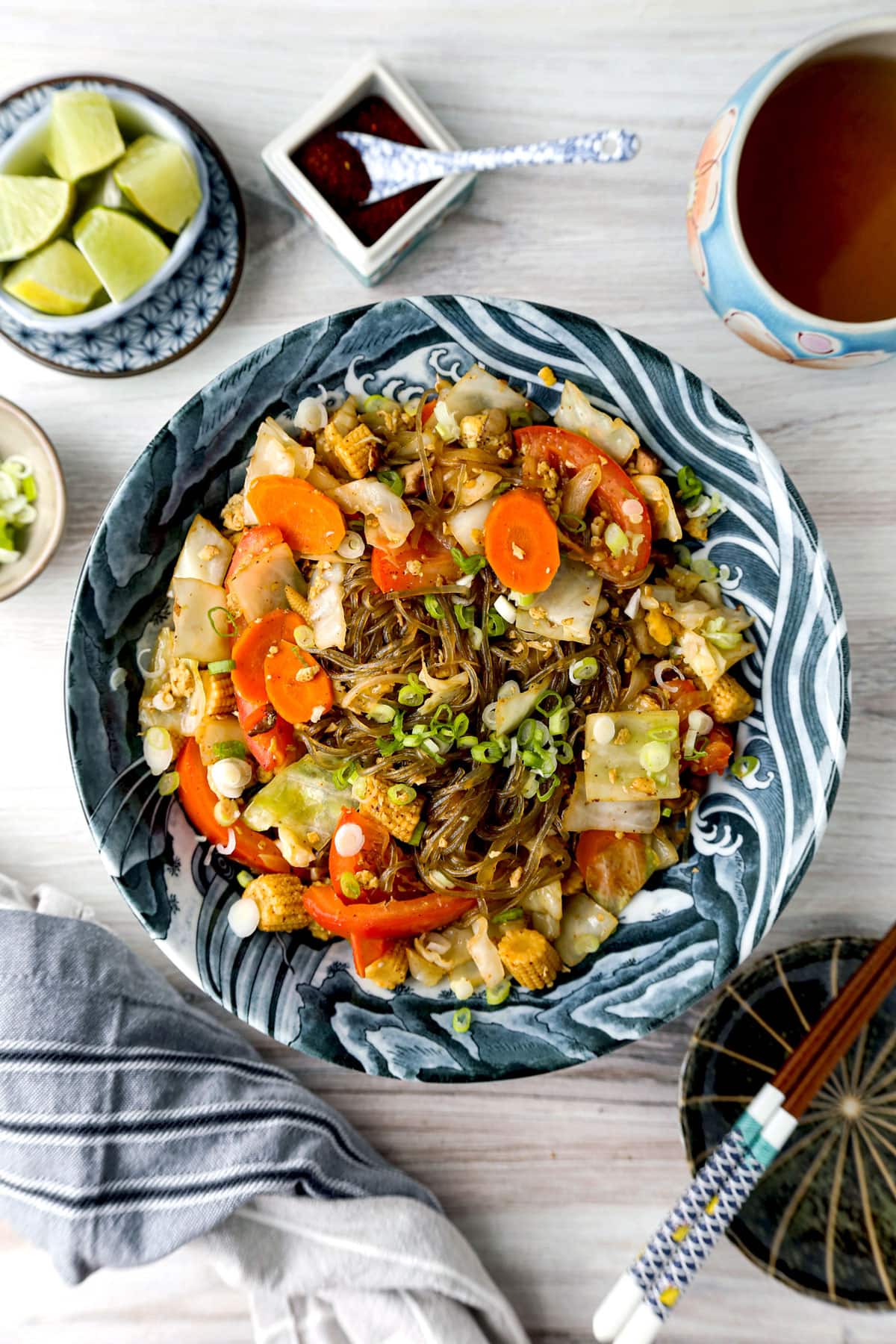
Pad Woon Sen (Thai Glass Noodle Stir Fry)
Sure, pad Thai is more well known in the West (and we’ll talk about it in a sec). But pad woon sen is the Thai noodle dish I gravitate towards 9 times out of 10. Why? Because I’m an absolute glutton for glass noodles drenched in salty and sweet woon sen sauce (a combination of soy sauce, oyster sauce, fish sauce, sugar and chili powder). Many recipes call for meat like chicken or pork. And while those options are delicious, I’m using veggies and egg instead. Top this colorful Thai noodle recipe with chopped scallions and dig in!

Asian Garlic Noodles
You’re going to love these Chinese influenced garlic noodles. Not only are they easy to make, you probably have everything you need in your pantry right now. A garlicky sauce, fortified with soy sauce, chili oil and sesame oil coats the noodles. I’m using thin dried spaghetti (trust me, it works!), but feel free to use Chinese egg noodles if you’ve got them handy. Serve at room temperature or cold with plenty of herbs and sliced cucumber. Makes the best midnight snack too!
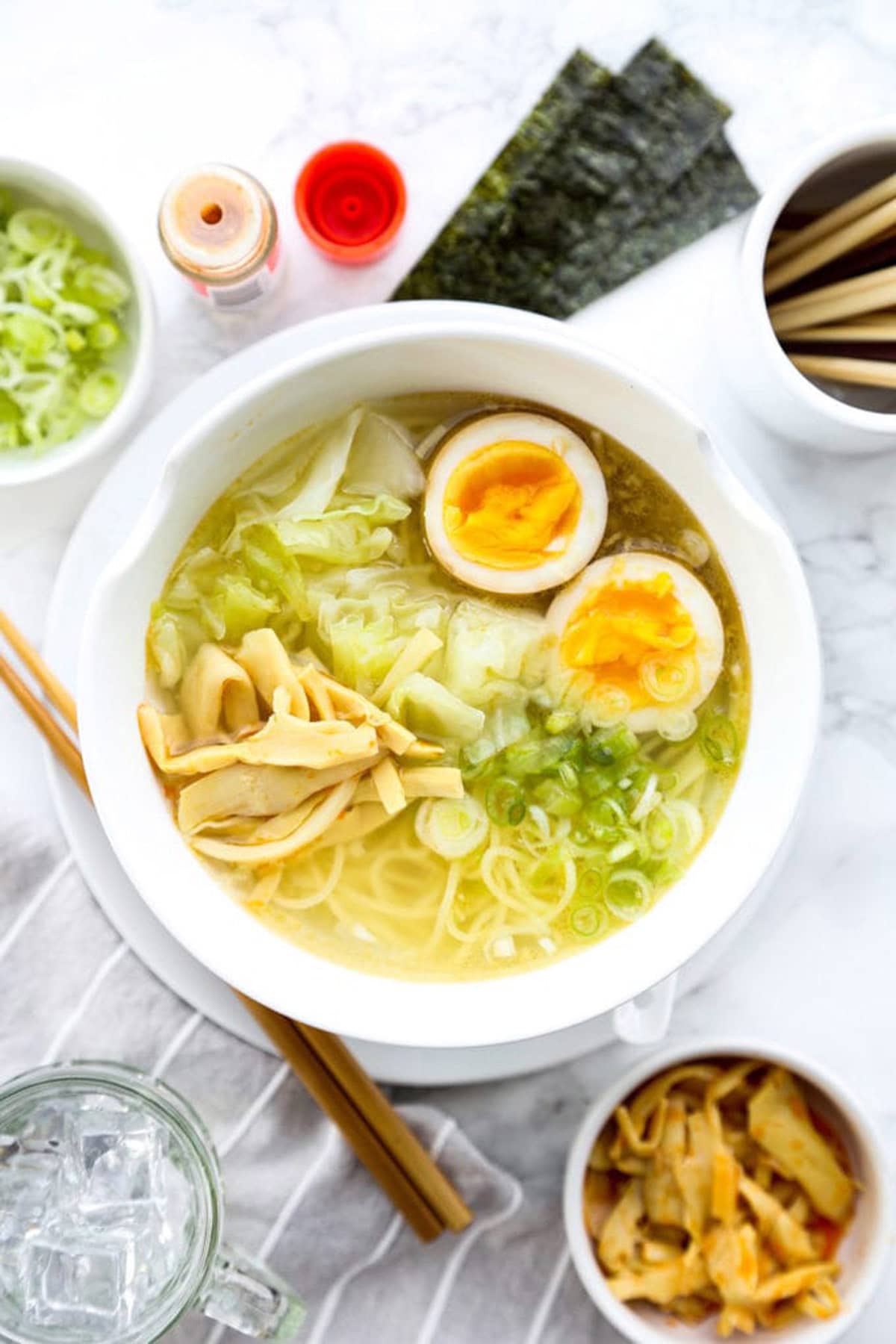
Shio Ramen (Salt Flavored Ramen – 塩ラーメン)
If you find the idea of making ramen from scratch at home intimidating, I hear you. It seems like a lot. But this hakodate inspired shio ramen recipe is as easy as it gets – while still tasting as good as the offerings from your favorite ramen shop. ‘Shio’ is Japanese for salt. But the broth isn’t simply salty. It’s a savory, sweet and sharp mix of dashi, sake and mirin – coupled with a fragrant mix of garlic, ginger and scallion that has been lightly sauteed in sesame oil. The delicious results belie the fact that you made it at home in less than a half hour.
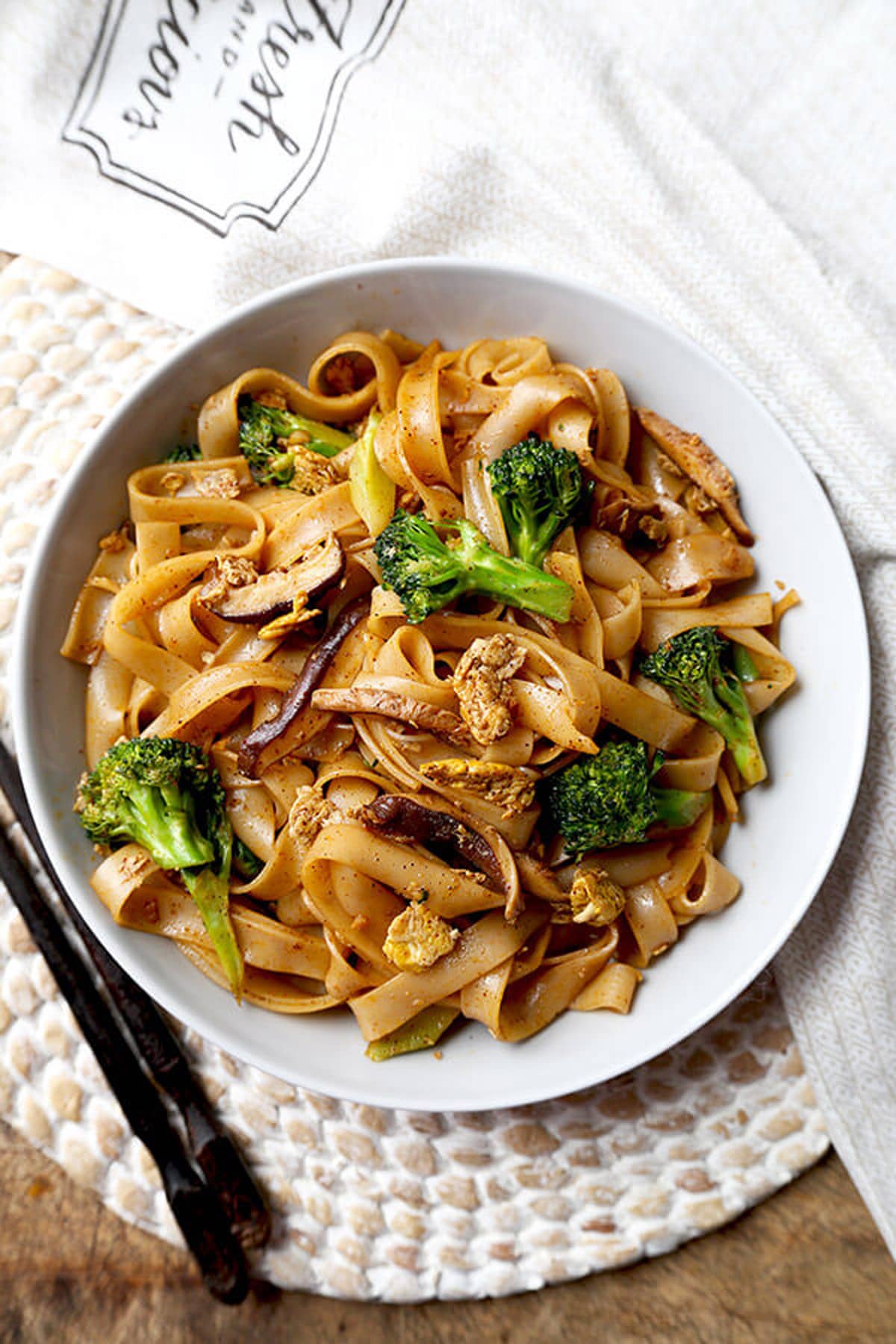
Vegetable Pad See Ew (Savory Thai Stir Fried Noodles)
This Thai takeout favorite is so easy to make at home, you may never order it for delivery again. Don’t believe me on the easy part? Just watch this video. Rice noodles are quickly stir fried with mushroom, broccoli and eggs. Traditional Thai recipes tend to utilize a protein like chicken, beef, pork or seafood. Use those if you like – or keep it super simple. Your choice. What isn’t optional is the mixture of fish sauce, regular or light soy sauce and a tbsp of sweet dark soy sauce. Do you have Thai chilis in your pantry? Now would be a good excuse to chop some of them up.
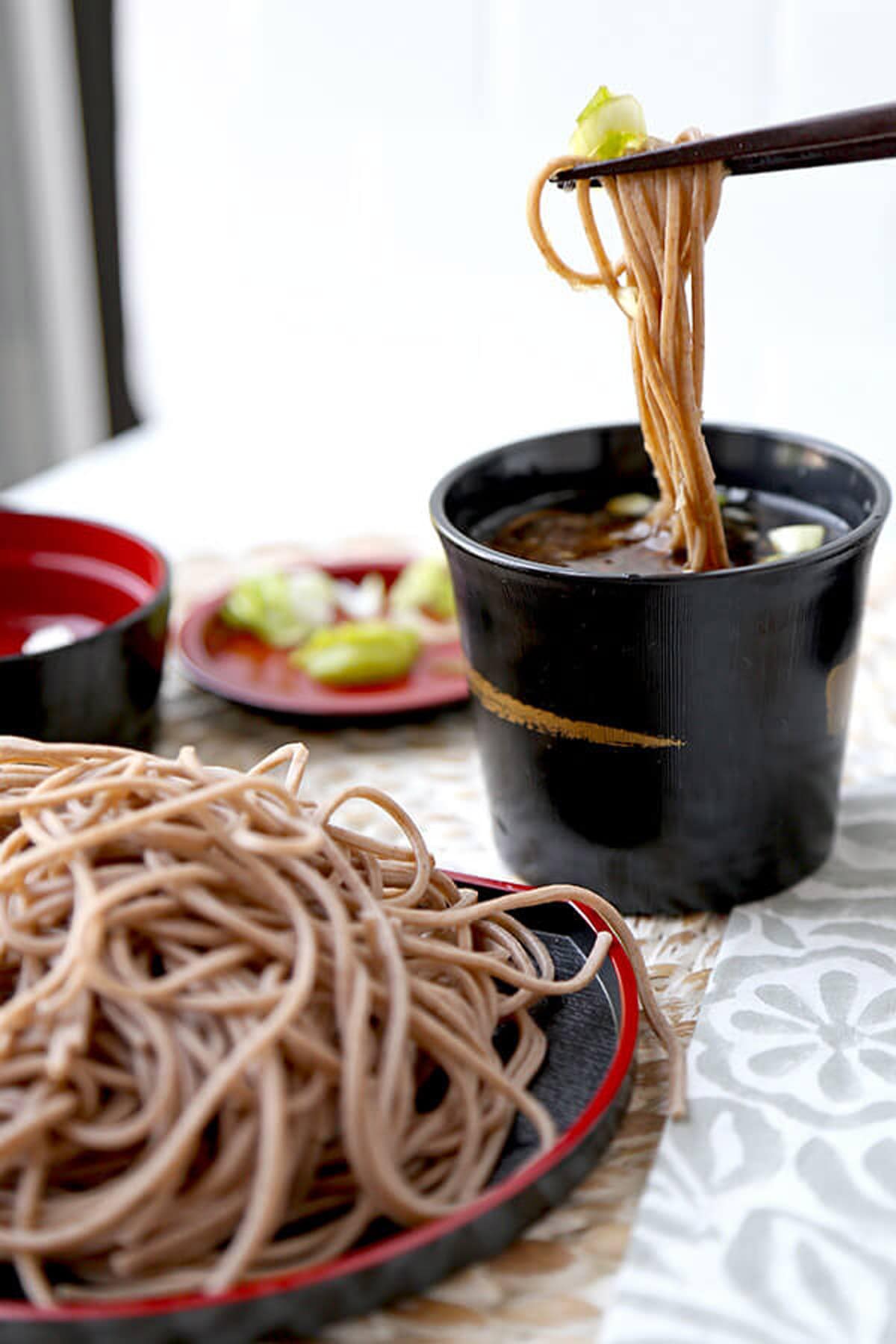
Zaru Soba (Cold Soba Noodles – ざるそば)
Soba noodles are Japanese buckwheat noodles. And while you can serve them hot in a bowl of soup – when the summertime hits in Japan, they are served chilled with a side of cold mentsuyu broth. Mentsuyu is a sauce made with bonito flakes, mirin, soy sauce, sugar and kombu (dried kelp). Or you can easily track down pre-made mentsuyu concentrated broth at your local Asian grocery store. Either way, this iconic cold soba is how Japan eats during the hottest summer months. And – full disclosure – I eat this easy and delicious Japanese dish year round.
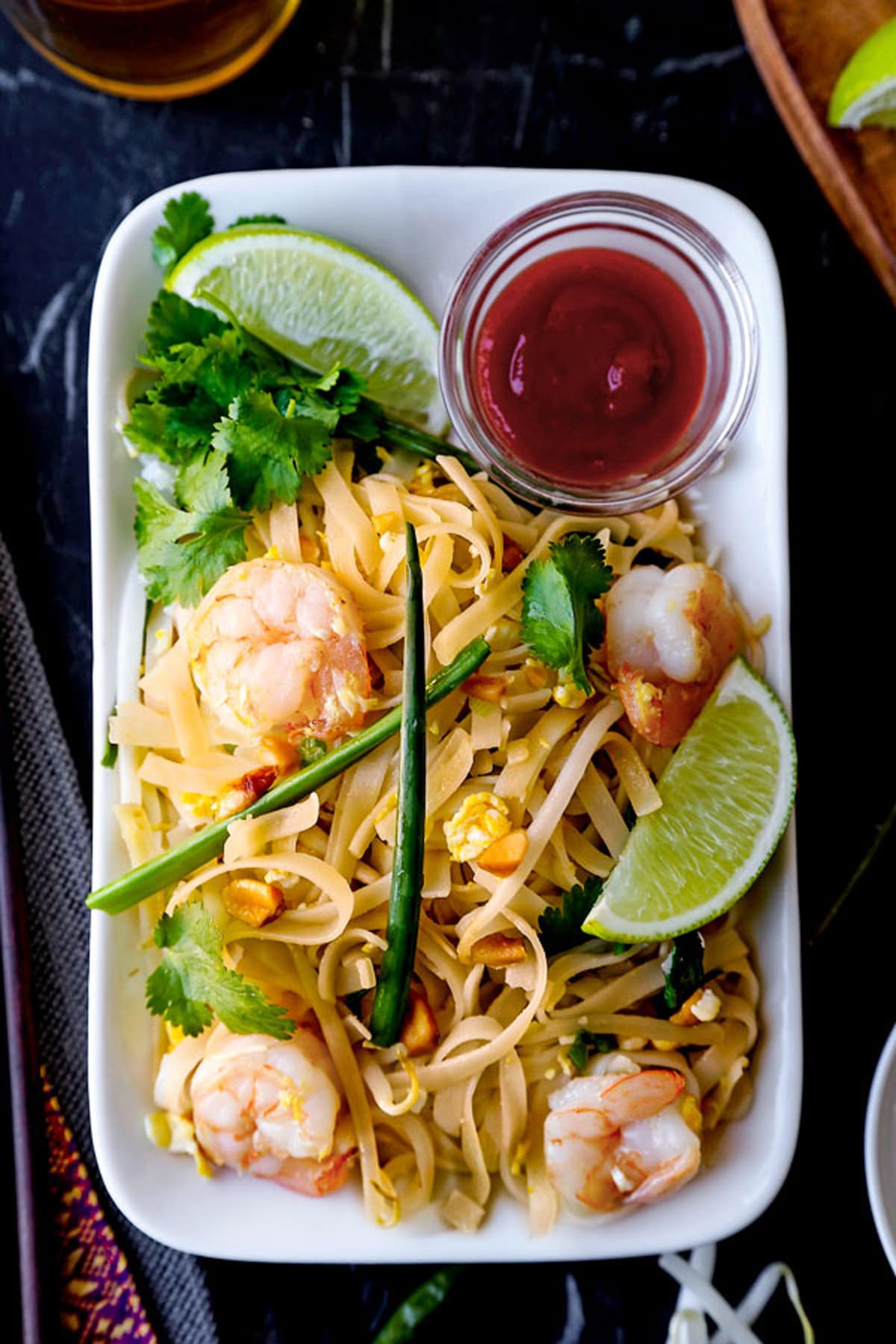
Classic Pad Thai Recipe
One of the coolest things about eating pad Thai in Thailand is the moment they set the spice / condiment caddy down on the table – and you start to augment the dish to your personal taste. Some people like it sweet and add a bit more sugar, some like it volcanic and add dried red chili pepper. Other common additions are crispy fried garlic, shallots, crushed peanuts, tiny dried shrimp and fish sauce with sliced Thai chili. The point is, pad Thai is meant to be personalized to your specific taste. How will you personalize this one?
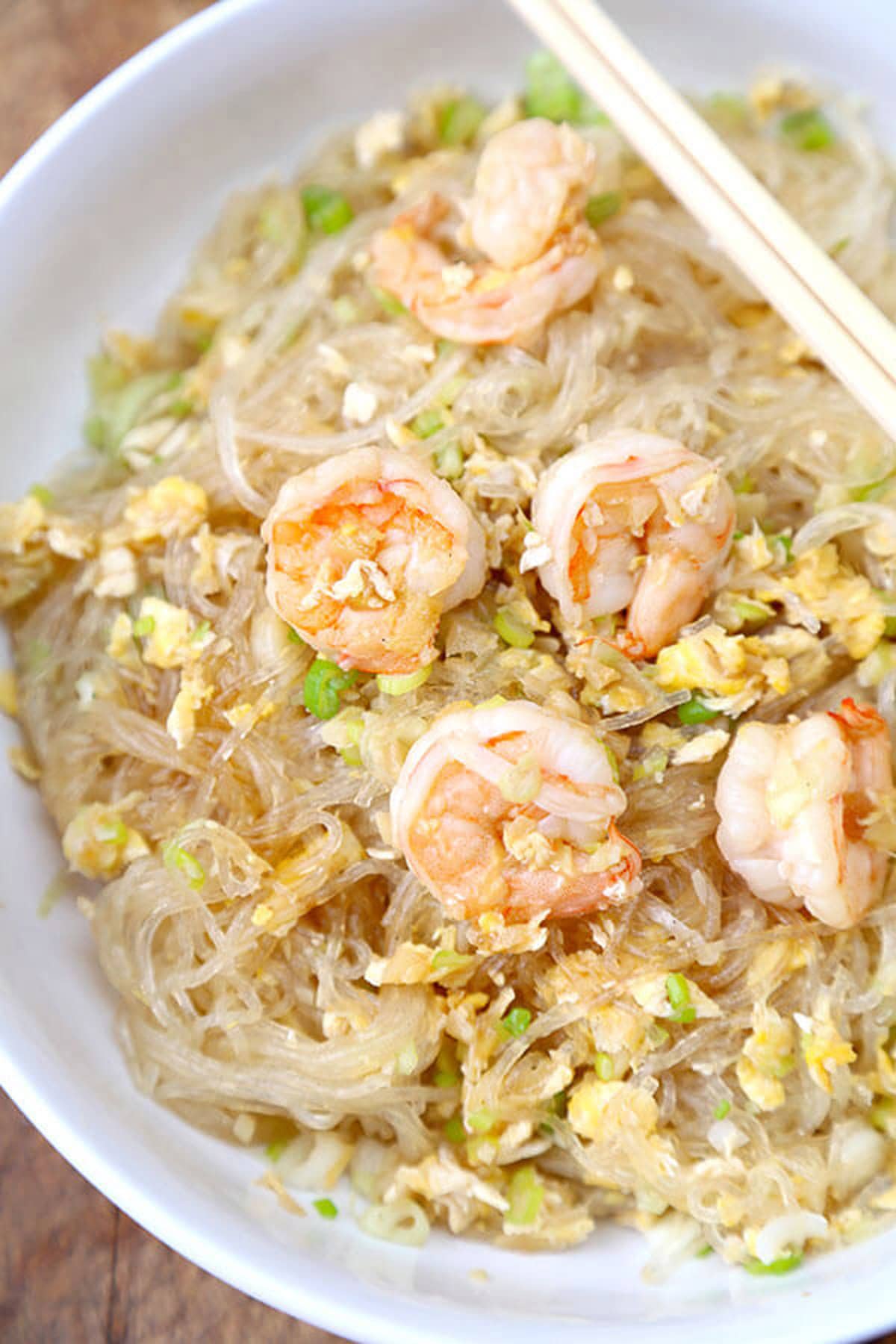
Stir Fried Glass Noodles With Shrimp
This is one of those Asian noodle recipes I tend to make at the end of a long day. But not only because it’s so easy to whip up. In my book, noodles are comfort food. And I find the marinaded shrimp tossed with eggs and bean thread noodles to be the food equivalent of a warm blanket on a cold day. These stir fried noodles are a nod to the simple, quick wok recipes, thrown together over humble gas burners in hawker centres. 15 minutes is all you need!
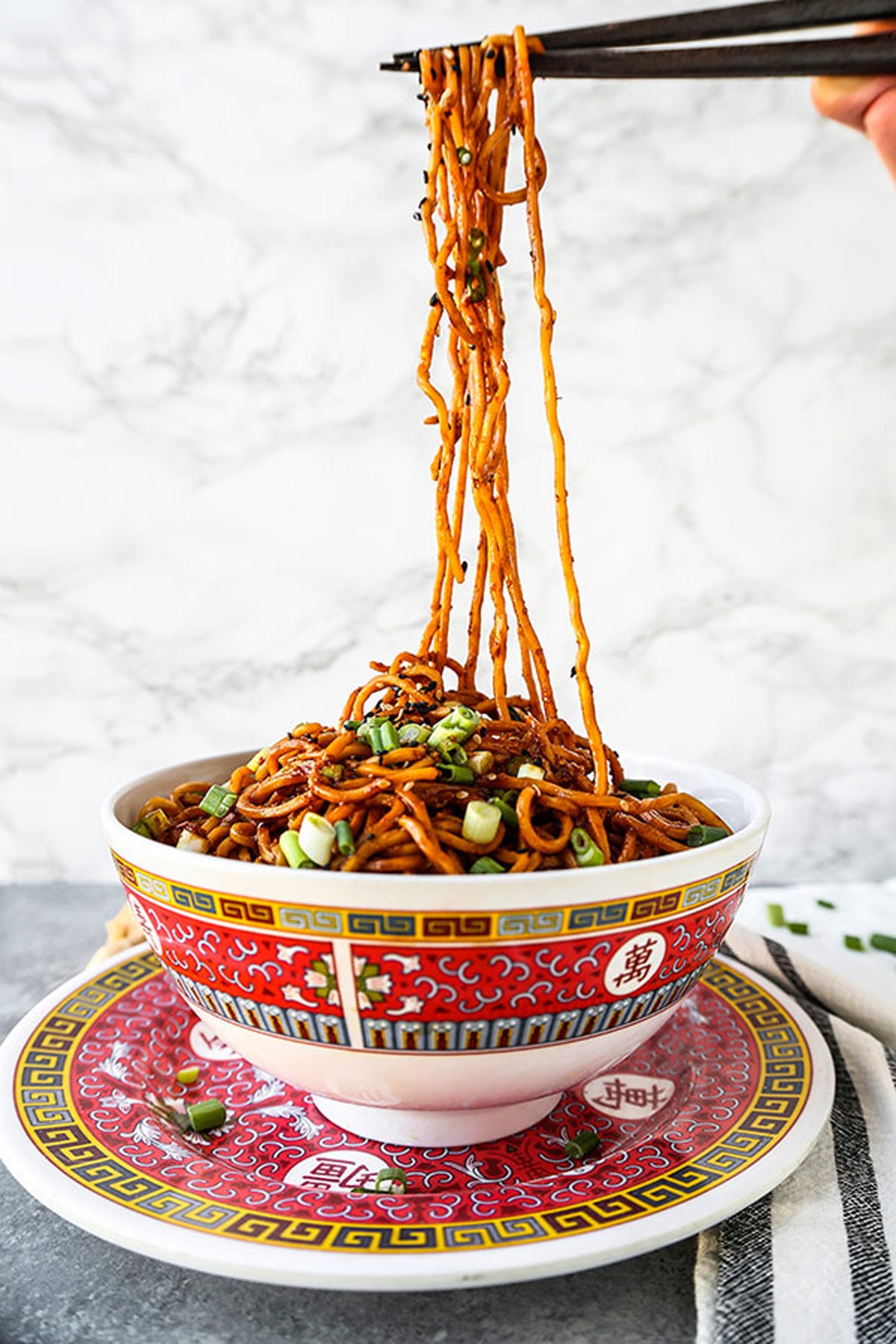
Aromatic Sour Chinese Egg Noodles
I make this egg noodle dish on Chinese New Year. Every year. You see, noodles signify a long and healthy life (so make sure not to cut them short!). Soy sauce and rice vinegar impart a savory / sour balance – while star anise, garlic, ginger and cinnamon make the whole thing… moreish. But it doesn’t have to be a holiday celebration to enjoy these delicious Chinese noodles. Any old random weeknight works as well!
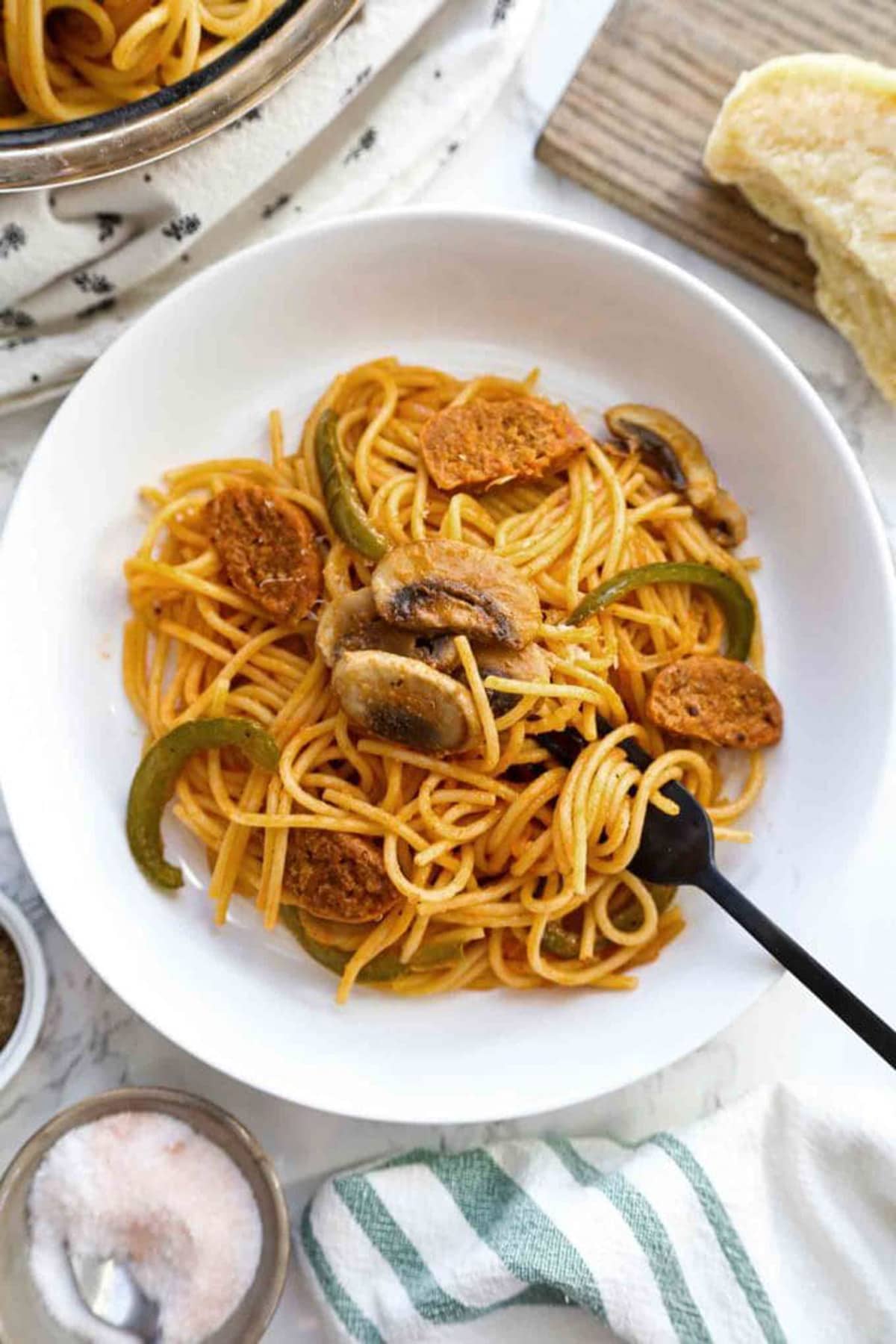
Spaghetti Napolitan – ナポリタン
This is the Japanese spaghetti of my childhood. And while ketchup (!) flavored spaghetti doesn’t seem very Japanese at first glance, Napolitan is one of the iconic Western influenced yoshoku recipes that gained popularity in Japan at the end of WWII. You can use Japanese kurobuta pork sausages – or use plant based sausages (your choice). What isn’t optional is the tomato ketchup. This Japanese pasta recipe is sweet, salty and perfect. One bite and I’m instantly transported to 6 years old, visiting family in Japan. And I still love it as an adult!

Vegan Jajangmyeon (Korean Noodles With Black Bean Sauce)
Korean black bean paste gives these iconic Korean noodles an inky hue. I’m using veggies instead of the pork you’d find in a traditional jajangmyeon. But the one constant is the udon noodles. They’re chewy, slippery and perfect. Fresh sliced cucumber cuts through some of the more dark, savory tasting notes in this dish – and imparts a fresh, crispy crunch. Don’t be intimidated by the long ingredients list. This one is ready in 30 minutes – including prep!

Spicy Miso Tsukemen (Dipping Noodles)
Japanese ramen gets all the love. But tsukemen deserves some attention too. Tsukemen are Japanese dipping noodles. The main difference from a composed bowl of ramen is that the noodles and broth are served separately. Grab your noodles from one bowl, and dip in a strong highly concentrated miso broth and slurp! While the broth is on the spicy side, it isn’t volcanic. If you like your tsukemen on the hotter side, add ichimi pepper to your heart’s content.
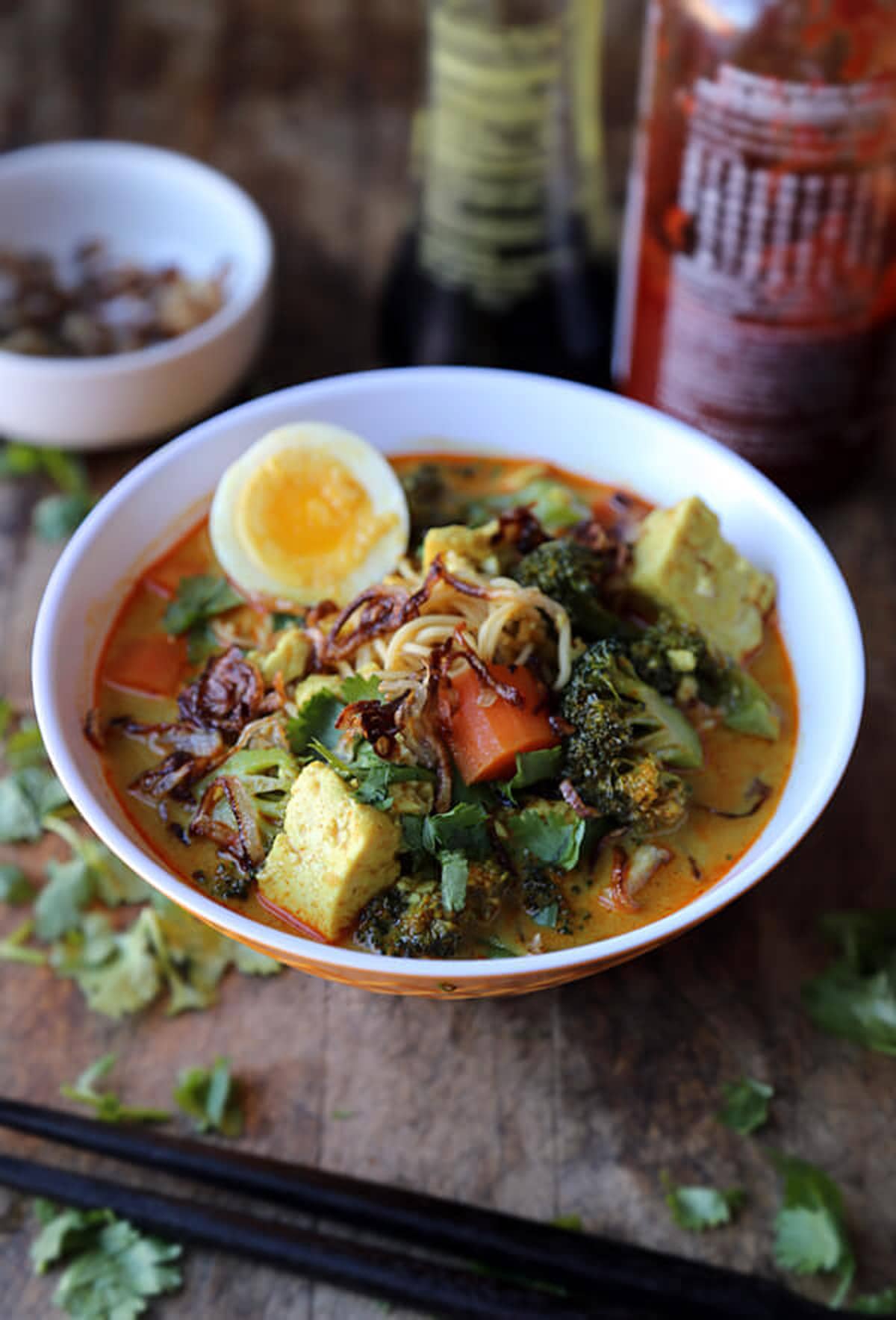
Thai Vegetable Curry Noodle Soup
Red curry paste is the star of the show in this fragrant Thai noodle soup. And I rounded out the flavor profile with judicious use of coconut milk and fish sauce. It has a balance of heat, sweetness and saltiness. Now, when it comes to the other ingredients, use your best judgement. I used carrot, broccoli, tofu and a boiled egg. But go with what you’ve got handy in your pantry. Top with cilantro for a clean herbaceous punch. And don’t forget the fried shallots.
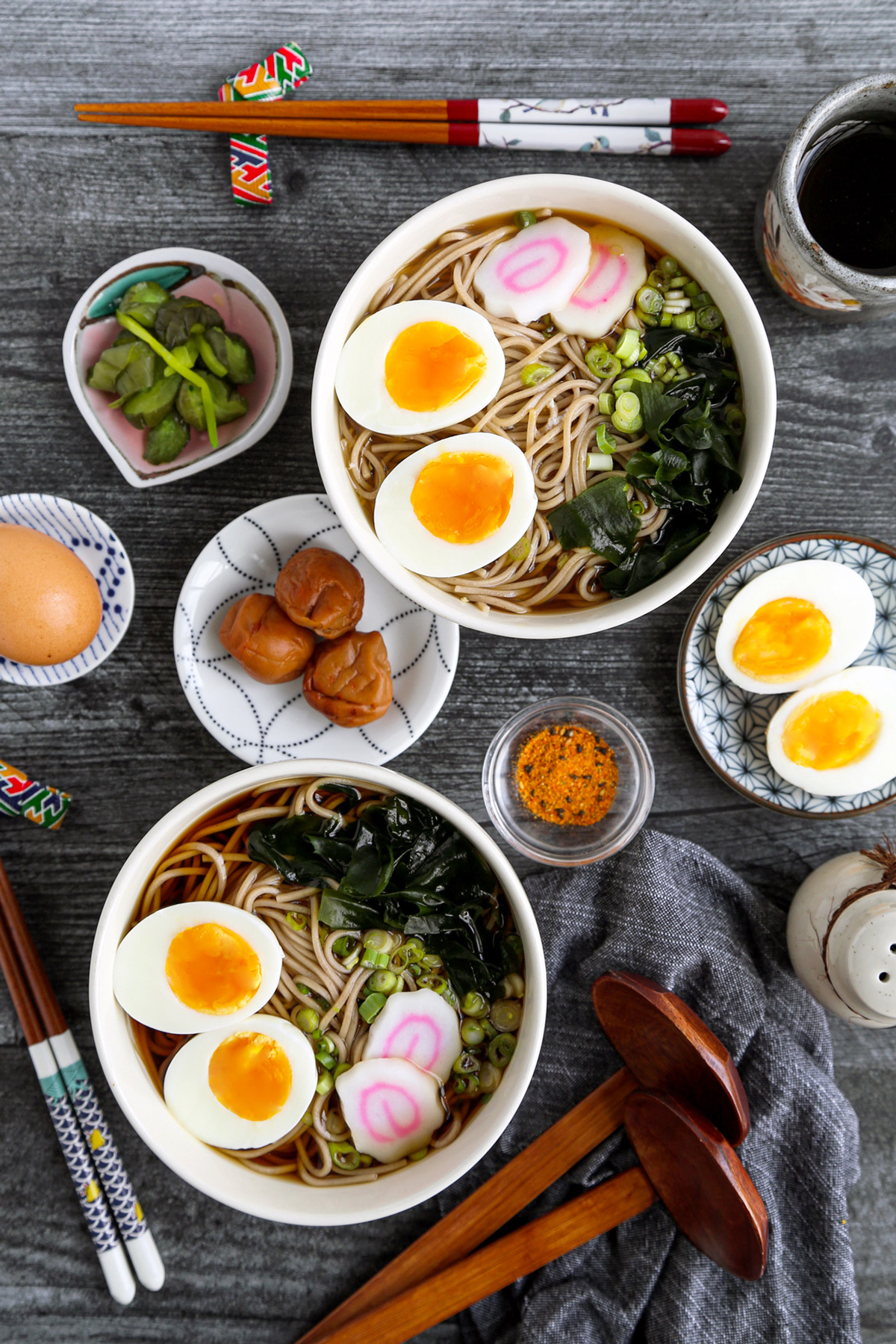
Toshikoshi Soba (New Year Soba)
I make toshikoshi soba every new year’s eve. It’s a dish traditionally eaten in Japan to acknowledge the ending of one year – and the beginning of another. And, as you may have guessed, the noodles themselves symbolize long life. This Japanese recipe is a simple combination of buckwheat noodles served in a warm tsuyu broth. Top with chopped scallions and wakame (seaweed) for the full toshikoshi experience. Eggs aren’t a traditional addition – but they’re plenty delicious!
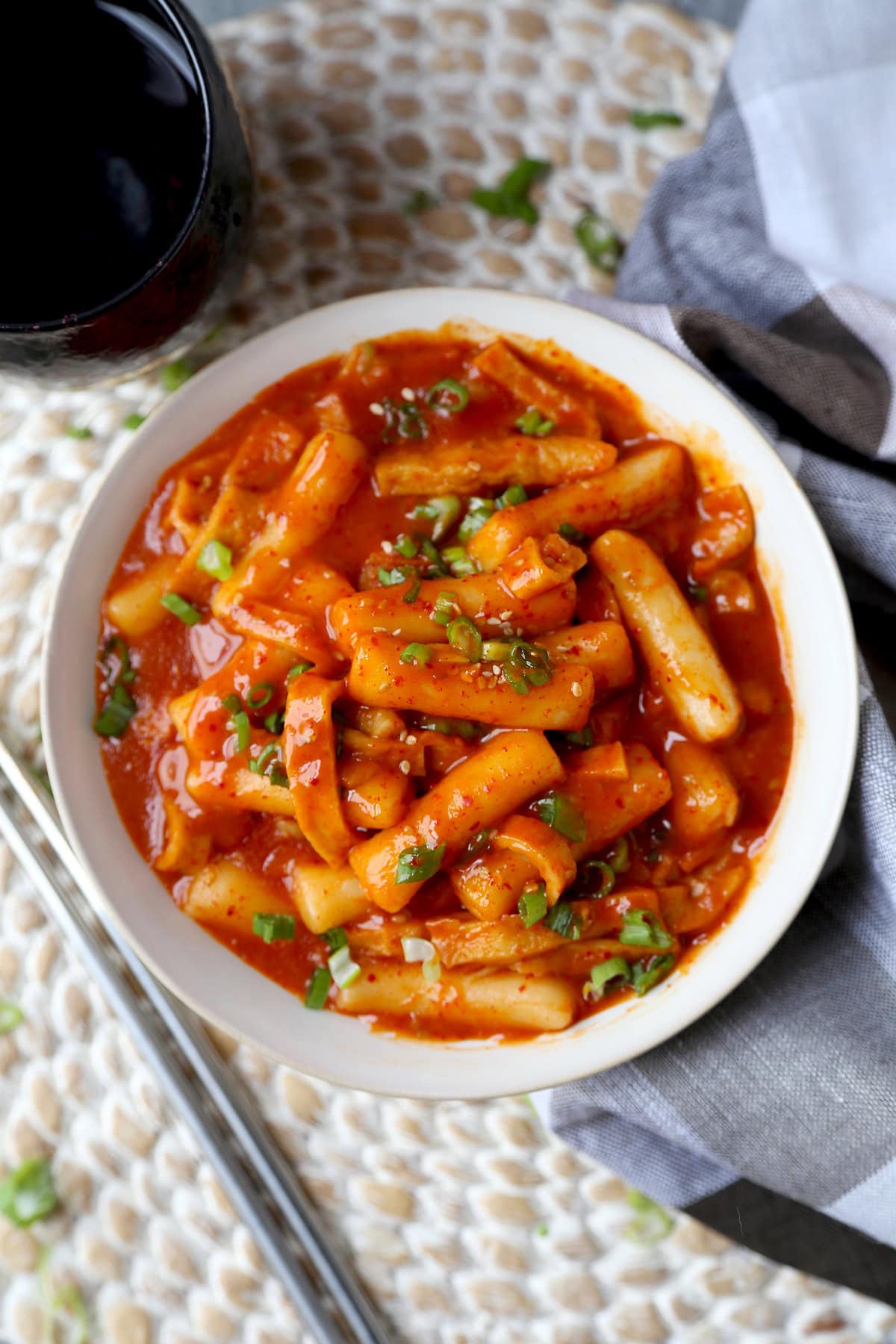
Tteokbokki (Dukbokki) – 떡볶이
Wait, aren’t tteokbokki rice cakes? Yes – but there’s a fine line between rice cakes and thick rice noodles! Tteokbokki is a Korean classic. The rice cakes are chewy, sweet and fiery. Gochujang and gochugaru bring the funky heat. And you’re going to love the sliced fish cakes. Tteokbokki is one of Korea’s most famous street foods, sold in pojangmacha (street food stalls on wheels). And it’s so delicious after a few too many glasses of soju!

Cold Asian Noodle Salad
This is one of the easiest and most refreshing Asian noodle recipes of all time. You can use egg noodles or spaghetti (your choice). Bean sprouts and sliced cucumber are crunchy and naturally cooling. And the spicy, tart and nutty sauce is simple enough to toss together quickly if you just remembered you need a last minute side dish for an outdoor bbq or backyard cookout. Serve cold!
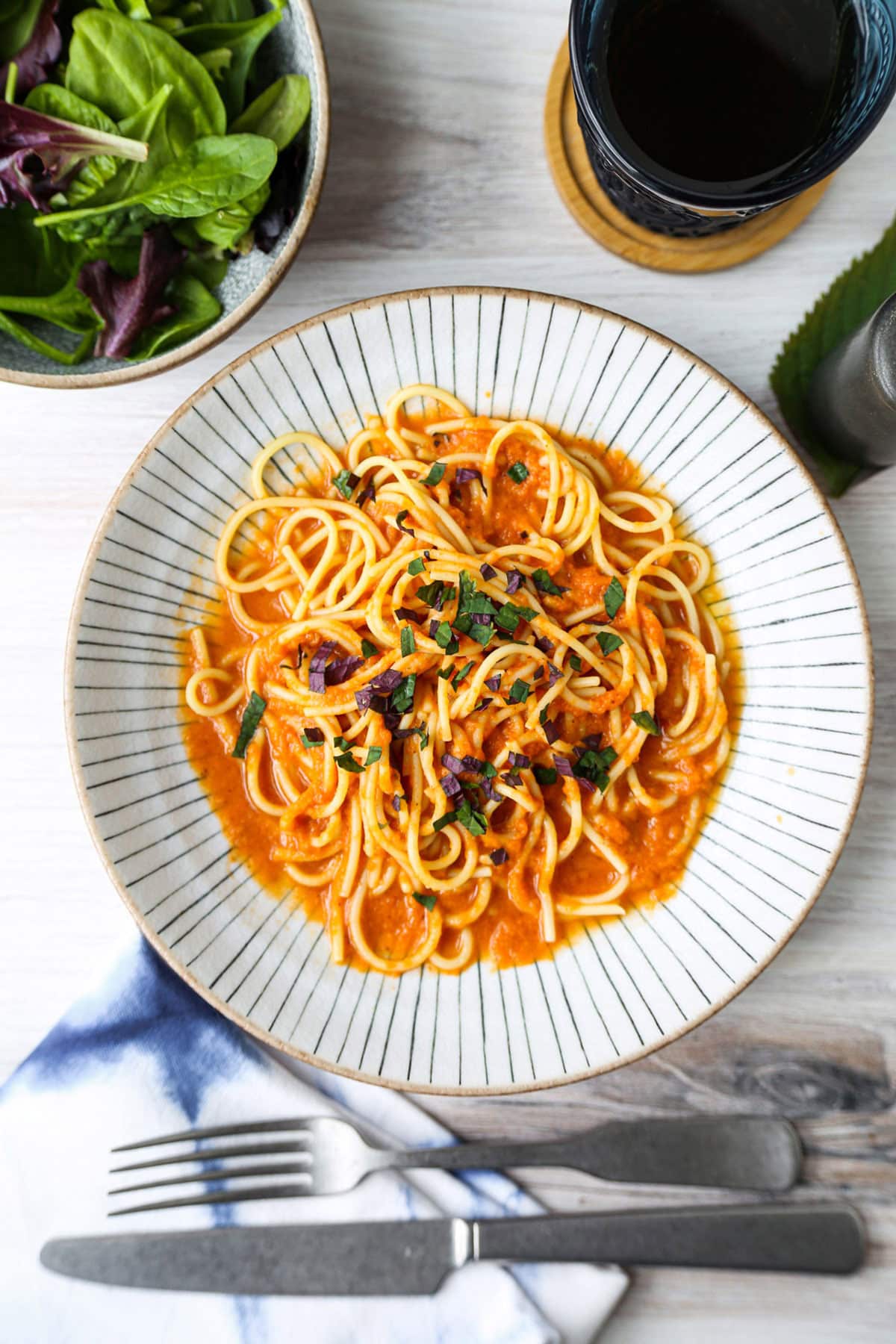
Chilled Japanese Tomato Shiso Pasta
This is a wafu Japanese pasta recipe. Wafu is a term used to describe something that has a ‘Japanese style.’ So, while spaghetti with tomato sauce may not be the most Japanese thing of all time – the ingredients list makes it so. You’ll add soy sauce, miso paste and dashi powder to this recipe for legions of umami goodness. Rice vinegar brightens the whole thing up considerably (and works so well with the tomatos). And don’t forget the shiso leaves!

Sesame Noodles
We’ve arrived at one of the most iconic American-Chinese take out noodle recipes ever. And, while they’re delicious, I sometimes find the delivery version a little too sweet, gloppy and one-note for my taste. This version is spicy, nutty, acidic and umami. More like the versions you’d encounter on Mainland China or Taiwan. Try making them yourself at home – and see how easy it is to whip up sesame noodles from scratch!
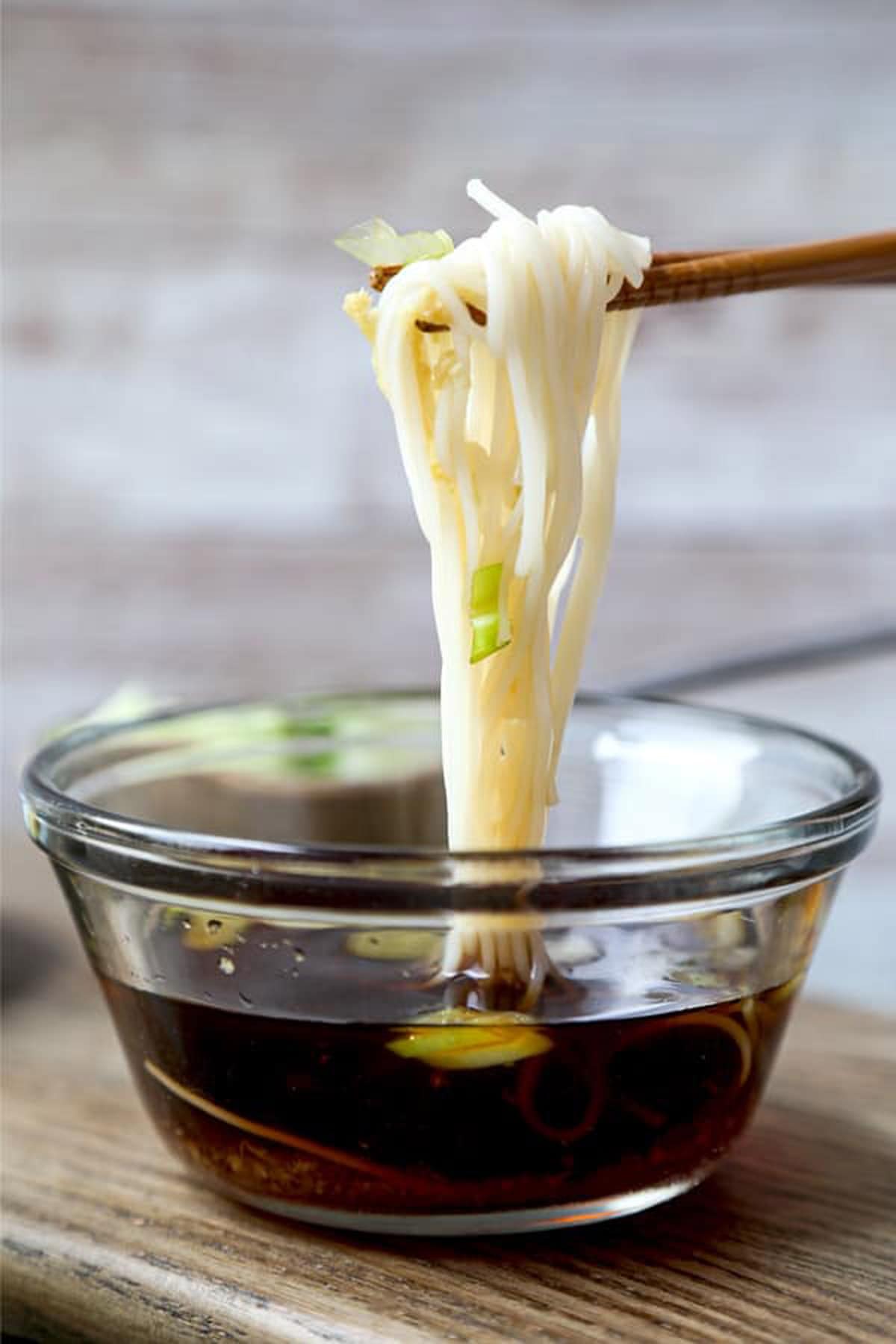
Somen Noodles – そうめん
Somen are super thin wheat noodles that have a springy, bouncy texture when cooked al dente. And they are all the rage during the steamy summers in Japan. These refreshing cold noodles are sometimes served in a bowl of ice water to keep them frigid. They are then dipped in a separate container of umami loaded mentsuyu broth. Careful not to over-boil your somen noodles. They cook fast!
Have you tried any of these easy Asian noodle recipes? Are there changes you made that you would like to share? Share your tips and recommendations in the comments section below!














